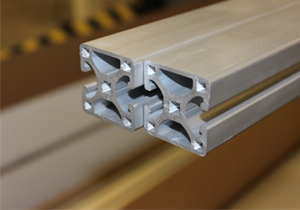Posted by Electromechanical Team on Tuesday, February 14, 2017
 Do you have a stack of t-slot aluminum framing catalogs or a folder of pdf datasheets from extrusion manufacturers that contains an almost endless amount of data on the material? For a person who specializes in this area, deciphering the material specifications for t-slot aluminum structural framing can be a fairly simple task. On the other hand, someone new to this process is likely to have questions.
Do you have a stack of t-slot aluminum framing catalogs or a folder of pdf datasheets from extrusion manufacturers that contains an almost endless amount of data on the material? For a person who specializes in this area, deciphering the material specifications for t-slot aluminum structural framing can be a fairly simple task. On the other hand, someone new to this process is likely to have questions.
- What’s the difference from extrusion to extrusion?
- Why are there so many?
- What’s the best option for my application?
Understanding more about aluminum alloys can help answer those questions.
Types of aluminum alloys
An alloy is chemical composition added to aluminum that strengthens the element. There are many types of alloys that are best suited for specific applications. Have you ever seen the extrusion rating 6105-T5 in a catalog? Before we break this number down, we must understand that there are at least three groups that are commonly used to categorize the alloys for extrusion.
- Commercially pure aluminum alloys are made up of roughly 99% aluminum, have excellent corrosion resistance, a high degree of workability and possess high thermal and electrical conductivity.
- Heat-treatable alloys are strengthened by solution heat-treating the alloyed metal to a specific point, adding the solute to the aluminum and then rapidly cooling it. The last part of the process is called aging. This can be done by natural aging, which is done at room temperature, or by artificial aging, which is done in a low temperature furnace.
- Non heat-treatable alloys are strengthened by a process called cold working. Cold working occurs during rolling and forging methods. The “working” action increases the strength of the metal.
The information in this table shows the alloy series number, alloying element used and the alloy category we described above. The first number of the series number identifies the major alloying element. So, if we take our example, 6105-T5, we find that this extrusion is heat-treated with the alloying elements of magnesium and silicon.

Tempering aluminum alloys
What about the “-T5”? This is called the temper. Tempering is a process of heat-treating, which is used to increase the toughness of iron-based alloys. There are four basic tempers:
- -F means fabricated
- -0 means annealed
- -H means strain hardened
- -T thermally treated
There are many references online describing the numerical values that follow the first character of the temper designation. For our example, the -T5, tells us that the alloy is cooled from an elevated temperature shaping process stress-relieved by stretching and then artificially aged. Aluminum extrusions and accessories are also commonly specified with a -T6, which is heat treated and artificially aged. The mechanical properties limits are not affected by cold working. The -T-66 is another temper that has the same processing as a -T6, but has an increased mechanical property level due to special controls of the process.
Selecting the best option for your t-slot application
T-slot aluminum framing products are typically classified in the 6000 series, supporting the fact that they are perfect for structural applications. The degree of strength will vary within the series of framing. When selecting one type of framing over another, remember there can be a premium associated with the stronger material.
Consider adding this information to your list when selecting material:

Learn more
You can learn more about our t-slot aluminum framing products on our solutions site, where you will find product information, application examples, videos, and more.
Sources
Davis, J.R., Corrosion of Aluminum and Aluminum Alloys.pdf, www.asminternational.org, 1999
Article contributed by Mario Mitchell, product manager, IPS t-slot aluminum framing, Electromechanical and Drives Division, Parker Hannifin Corporation.
